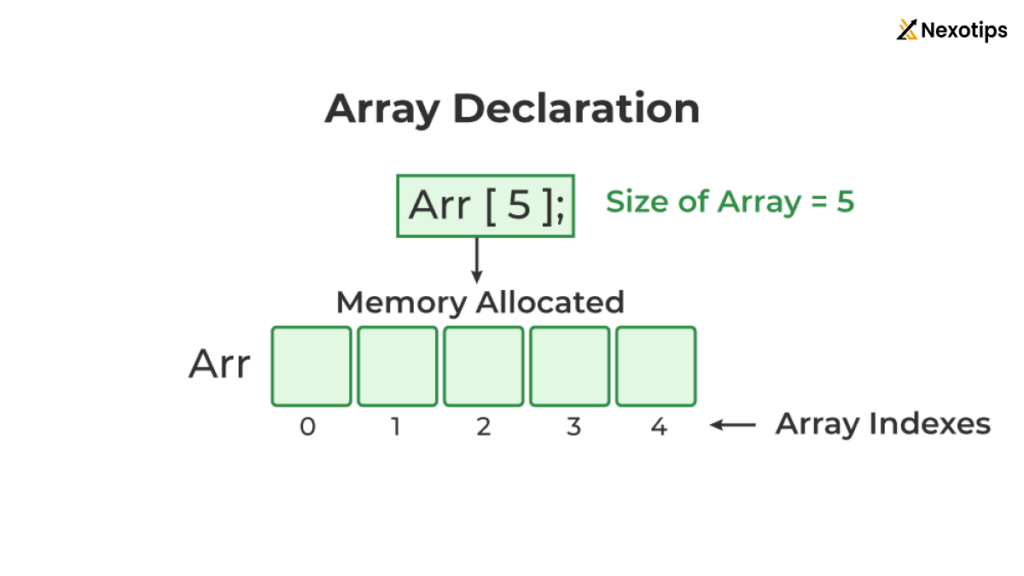
Mastering Arrays in C Programming: A Comprehensive Guide in 8 pints.
Arrays in C
Arrays are a fundamental data structure in the C programming language, providing a convenient way to store multiple values of the same type under a single variable name. They are widely used in various applications due to their simplicity and efficiency. This blog post will explore the concept of arrays, their declaration, initialization, usage, and some advanced topics related to arrays in C programming.
Table of Contents
1. Introduction to Arrays
An array is a collection of variables of the same type, stored in contiguous memory locations. Instead of declaring multiple variables for each value, an array allows us to use a single variable name with an index to access each element. This makes the code more readable and easier to manage.
2. Declaring Arrays
To declare an array in C, you specify the type of its elements and the number of elements it can hold. The syntax for declaring an array is:
type arrayName[arraySize];Here, type is the data type of the elements, arrayName is the name of the array, and arraySize is the number of elements the array can hold.
Example:
int numbers[10]; // An array of 10 integers
char letters[5]; // An array of 5 characters
3. Initializing Arrays
Arrays can be initialized at the time of declaration. You can provide a list of values enclosed in curly braces {}. If you do not initialize all elements, the remaining elements are set to zero for numeric types or NULL for pointer types.
Example:
int numbers[5] = {1, 2, 3, 4, 5}; // An array of 5 integers initialized with values
char vowels[5] = {'a', 'e', 'i', 'o', 'u'}; // An array of 5 characters initialized with vowelsYou can also let the compiler determine the size of the array by omitting the array size:
int numbers[] = {1, 2, 3, 4, 5}; // The compiler will set the size to 54. Accessing Array Elements
Array elements are accessed using the array name followed by the index of the element in square brackets []. Array indices start at 0, meaning the first element is at index 0, the second element is at index 1, and so on.
Example:
int numbers[5] = {1, 2, 3, 4, 5};
printf("%d", numbers[0]); // Output: 1
printf("%d", numbers[4]); // Output: 5You can also modify the value of an element by assigning a new value to it:
numbers[2] = 10; // Changing the third element to 10
printf("%d", numbers[2]); // Output: 105. Multi-dimensional Arrays
C allows the creation of multi-dimensional arrays, which are arrays of arrays. The most common multi-dimensional array is the two-dimensional array, often used to represent matrices.
Example:
int matrix[3][3] = {
{1, 2, 3},
{4, 5, 6},
{7, 8, 9}
};Accessing elements in a two-dimensional array requires specifying both row and column indices:
printf("%d", matrix[1][2]); // Output: 66. Passing Arrays to Functions
In C, arrays are passed to functions by reference, meaning that the function can modify the original array. To pass an array to a function, you need to specify the array’s name without brackets.
Example:
void printArray(int arr[], int size) {
for(int i = 0; i < size; i++) {
printf("%d ", arr[i]);
}
}
int main() {
int numbers[5] = {1, 2, 3, 4, 5};
printArray(numbers, 5);
return 0;
}
7. Common Array Operations
Arrays in C are versatile and can be used for various operations such as sorting, searching, and manipulating data.
Sorting:
#include <stdio.h>
void bubbleSort(int arr[], int n) {
for(int i = 0; i < n-1; i++) {
for(int j = 0; j < n-i-1; j++) {
if(arr[j] > arr[j+1]) {
int temp = arr[j];
arr[j] = arr[j+1];
arr[j+1] = temp;
}
}
}
}Searching:
#include <stdio.h>
int linearSearch(int arr[], int n, int key) {
for(int i = 0; i < n; i++) {
if(arr[i] == key) {
return i;
}
}
return -1;
}8. Advantages and Disadvantages of Arrays
Advantages:
- Easy to use and understand.
- Efficient access to elements using indices.
- Suitable for sequential data storage.
Disadvantages:
- Fixed size: Once declared, the size of an array cannot be changed.
- Wastage of memory if the array is not fully utilized.
- Insertion and deletion operations are costly.
Arrays are a crucial part of the C programming language, providing a simple and efficient way to store and manipulate data. Understanding how to declare, initialize, and use arrays is essential for any C programmer. By mastering arrays, you can enhance your ability to work with more complex data structures and algorithms, ultimately improving your programming skills.
Feel free to explore more about arrays and practice implementing various operations to solidify your understanding. Happy coding!
Learn with us: Nexotips
Nexotips is a dynamic IT company specializing in web development and programming education. With a rich expertise spanning 5 years, we empower aspiring developers with skills in C, C++, HTML, CSS, Bootstrap, JavaScript, TypeScript, and Angular. Our mission is to cultivate proficiency in these essential technologies, equipping learners with practical knowledge to thrive in the digital landscape.
Others: Mastering Break And Continue Statements In C Programming For Optimal Coding Efficiency
